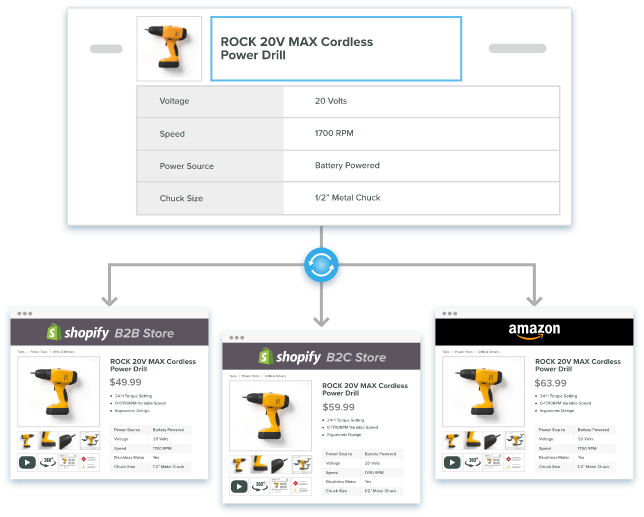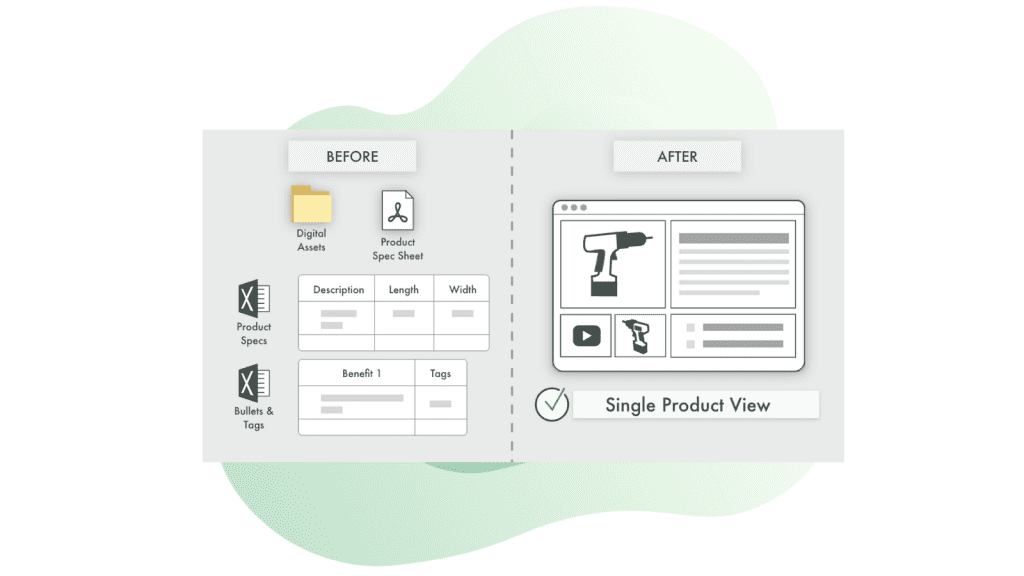For marketers accustomed to face-to-face conferences and printed catalogs, entering into the ever changing world of B2B eCommerce and B2B platforms can be daunting. Each year, more and more marketers struggle to find solutions for promoting products at scale. That’s why we’re bringing you the top b2b eCommerce marketing do’s and don’ts for scalable growth.
Global B2B eCommerce has increased in the past few years, with B2B sales projected to reach $1.2 trillion by the end of 2021. Your marketing strategies must be solid and focused on current market trends if you want to succeed in the market.
These tips are instrumental to elevating your marketing strategies, increasing sales, and scaling your B2B business for growth.
Let’s get to it.
The Top B2B eCommerce Marketing Do’s and Don’ts for 2022 and Beyond
DO: Utilize in-use photography.
Pictures are powerful. They appeal to human emotions and can trigger quick actions. This is why visual representation is crucial to B2B eCommerce success. Therefore, your photography choice must align with B2B standards to convey the correct information to your customers.

When you create images for your B2B eCommerce, you want to make sure it captures essential details and that they are large and of top, top quality. Apart from this. Images must provide customers with a clear understanding of how the product works.
In-use photography helps you build credibility, trust and loyalty. It also humanizes the product, which, as a result, can inspire a purchase. Your pictures must connect with the buyer’s emotions and that’s one way to influence purchase decisions and drive conversion.
One of the best tools you can use to optimizing digital assets for B2B eCommerce marketing at scale is a Digital Asset Management system.
Blog: 10 Reasons all B2B Enterprises Must Have a DAM in 2021
DON’T: Use boring language. Be creative with CTAs.
In the psychology of selling, using a call to action is a springboard to make sure customers take action by giving them clear direction or instruction on how to purchase your product. While this seems like something simple to do, it is not as easy as it looks.
Using the typical CTA language, such as “buy,” “sign up” “submit”‘ and “download” are ok to use, but they don’t always reflect urgency or the personality of your brand. Just because B2B platform products aren’t normally marketed in a creative manner, doesn’t mean you can’t improvise on your own eCommerce site. In fact, doing so will most likely set your purchase experience apart from your competition.
Instead, be creative. Creativity sparks action. Your creativity can really shine outside of the call to action button itself. Just above or below the button you can use this space to create a sense of urgency with phrases like “Sale Ends Soon” “Only 5 items left” or “15 other people have this item in their carts.”
If your company sells tools for construction companies, you might consider using “Start Building Now” or “Buy Today, Use Tomorrow” for a catchy CTA button. Aside from language, set your add to cart buttons apart by making it the brightest color on your page. Add dimension with different shapes, rounded corners or soft shadows so the visitor to your site will be drawn to it immediately.
DO: Provide customer-specific pricing.
A big misconception and preventer to B2B organizations entering into the eCommerce space is that you’ll no longer be able to offer customer specific pricing. This idea couldn’t be further from the truth. Customer-specific pricing is almost easier in the eCommerce world, with inventory and order history available to both customers and sales in a matter of clicks.
The drawing cad for customer-specific pricing is that it allows you to offer customers pricing that is unique to them, which can come with incentives or based on the history of the relationship between you and the buyer. For example, long-term returning customers may enjoy specific pricing for products they have bought consistently.

This system thrives on customer-level data, which you use to personalize the pricing and create a satisfying shopping experience. How you orchestrate your data structure on your site may largely depend on which eCommerce platform you’re using. In many cases, either BigCommerce or Shopify.
Customer-level pricing shouldn’t stop at your eCommerce site, however. It is equally crucial for your organization to be able to provide custom catalogs or price sheets for eager buyers. This means you’ll need to be able to create a custom catalog very quickly. One method of achieving this is by way of using Catsy PIM and InDesign integration.
Blog: Everything You Need to Know About Customer-Facing Product Content
DON’T: Settle for a keyword search bar. Enable Faceted Search as well.
Search features are essential to your eCommerce marketing. When you have an extensive catalog of products, customers must locate the products they need as quickly as possible, or they’ll leave your store. Unfortunately, the primary keyword search bar does not have filters that make the search experience seamless. So, instead of using keyword search only, enabling faceted search function is crucial.
Faceted search uses the metadata attributed to a product, allowing users to refine their search queries when looking for a product. By enabling customers to choose from a range of different filters associated with a product, they are able to narrow down their search and find what they want fast.
For example, on Catsy DAM Software, the faceted search function works both within DAM and your eCommerce website. Keywords such as file format, date, language, licensing, the brand allows the customers to streamline their search
Benefits of faceted search:
There are several benefits of using faceted search. One of the most important is ensuring that your customers don’t get lost in your product catalog. Remember that a better customer experience is at the core of all your marketing strategies. So by ensuring that customers have a seamless experience searching for products on your eCommerce site, you are improving their overall customer experience.
While customers may know what they want, they are usually not sure what it looks like. So they can end up making guesses when searching for a product. However, when you give them a list of parameters to choose from, you guide their thoughts and make it easy for them to get what they seek. With this, you will be empowering your customers.

In addition to this, bear in mind that your customers don’t have all the time in the world. When they have to deal with many options to choose from, they are likely to lose interest in the entire process. One of the results you want to achieve with faceted search is to avoid an information overload. Using filters to streamline their such cuts down the options they have to toggle, makes it less complicated, and allows them to do more with their time.
Let’s look at some faceted search best practices you should consider in your eCommerce setup.
1. Leverage product and user data.
Undoubtedly, data is crucial to your B2B eCommerce success. Here, the first thing to consider is that you have rich product data. You need this data to organize the most suitable and relevant filters for each product. Getting this right ensures that you do not end up with messy results.
In addition to this, faceted search gets better when you can incorporate user data. For example, when you notice customers seldom click on a filter, the best practice is to review why this is so. Is it irrelevant to what the customers are searching for? Then, you can either replace it or find a helpful alternative.
Your goal should be to continuously polish your faceted search filters based on customer data to improve their shopping experience.
2. Ensure filters are relevant.
The rule of thumb here is to put yourself in your customer’s shoes. For example, if you sell mountain bikes – full suspension, your filters should include category, gears, gender, and so on, as you see in the Catsy example above.
The more specific options you offer your customers, the easier it is to search and find the products they need quickly. This is especially true for top B2B eCommerce distributors.
3. Make it user-friendly.
Your faceted search interface must be user-friendly. Make sure your design choices are based on user experience. Understand that your preferences will also rely on the products you are selling, so there is no one size fits all.
4. Avoid “No Results Found”
Never leave your customers with a blank page. Imagine going through the process of carefully selecting the attributes they want to be applied, and they get no results. This will be a blow to their motivation, which could increase your eCommerce site bounce rate.
DO: Provide complete specifications.
The B2B buying cycle has multiple stages, and the first is research. According to a study, 81% of customers research a product before they make a purchase. During this research stage, they compare prices and product features from multiple vendors before deciding which one fits their needs. To make sure these customers trust your products, you must provide them with detailed and accurate product specifications.
In B2B eCommerce, customers rely on the accuracy of your product specifications and expect to get exactly what they ordered. That is why having accurate data is critical to your growth. It reduces the chances of customers returning products and improves customer satisfaction.
In a nutshell, you need to give complete specifications that answer any and every question they may have. It is vital that you can answer these questions, especially your prospective customers who come in different categories: novice, first-time visitors, and those who have adequate knowledge of what they need. Everyone in each category has questions that you must answer.
For example, a novice visiting your site for the first time needs to be educated and persuaded. Therefore, your B2B eCommerce platform site must provide a compelling case for why your products are the right choice for them, their benefits and other perks that come with them. Remember: data governance drives revenue.
Most importantly, you want to set it up in a way that captures their interest at first contact. Beyond just listing benefits, your specification should include clear, specific, realistic details that explain how a product works, its integration capacity, and physical characteristics. This is helpful information that draws a customer in and gets them to advance from prospecting to buying.
DON’T: Limit yourself to one store. Adopt multiple buyer personas through multi-store selling.
Selling through multiple stores is a sure-fire way to grow your B2B eCommerce company at scale.. According to Gartner, selling on more than one store allows you to create a broader ecosystem and reach a bigger audience. Apart from helping you generate new sources of revenue, you can also improve personalization by setting up stores based on buyer personas.
Buyer personas are an increasingly effective marketing method in the top B2B eCommerce space. Setting up multiple stores is fairly easy and straightforward using eCommerce platforms like Shopify. So, why don’t more companies use multi-persona marketing with multiple stores? The short answer: a lack of product information management.

We’ll get into what product information management is and why all B2B eCommerce companies need it in the next section. But for now let’s take a moment to discuss how you can manage product content for 1 products multiple marketing personas from one location using Catsy PIM (product information management).
Catsy stores all product information for your products in a single location. That includes everything: from product specs, marketing copy, attributes, inventory levels and pricing. The single source of truth ecosystem that a PIM solution provides makes creating buyer personas easy to manage and publish to perspective top B2B eCommerce platforms and stores.
As the illustration above articulates, you can link different titles and descriptions to a single product. Meaning, you can manage all personas in a single location, ensuring accuracy and spec consistency across all channels at all times.
Blog: B2B Shopify. A Match Made in Heaven for B2B eCommerce?
DO: Invest in Product Information Management.
B2B customers want a quality shopping experience. According to PWC, 86% of B2B buyers are willing to pay more for an excellent customer experience. At the base of a strong customer experience is personalization, which is fueled by solid Product Information Management (PIM).
PIM provides you with an intuitive interface to collect, manage and maintain all your product information. With it, you can export or import product data, create categories and distribute products to different sales channels.
When you want to scale your business, you must consider the diversity of your customer base, which may also cut across different countries and regions. This diverse customer base will have specific needs and expectations. It is, therefore, essential to have a system that allows you to have accurate product information that you can publish fast to meet the growing needs of your customers.

Essentially, PIM gives you control over your product information through a centrally managed source. It saves you time, ensures the quality of your product information and helps you deliver an exceptional customer experience. So if you are serious about growing your B2B eCommerce, you must invest in PIM.
Here are a few reasons why an investment in PIM can help you scale:
1. Product accuracy for top B2B eCommerce results.
The most important reason why you should invest in PIM is that it guarantees your product data accuracy. Essential information such as product specs and SKUs are updated in real-time, ensuring that only the latest and approved versions are available to your marketing teams.
2. PIM provides your team with more time to focus on marketing campaigns.
When running marketing campaigns, you want to make sure all your product information is readily available and up-to-date. In the past, spreadsheets were used for this purpose, but they are not equipped to match today’s data sharing’s fast-paced, real-time nature. However, with PIM, you can access accurate and updated information in real-time, making it easy to strategize and make your decisions based on current market trends.
3. PIM enhances team collaboration and communication.
PIM enhances collaboration in your marketing team. Everyone will have access to the latest versions of product information without worrying about using inaccurate data. It also allows seamless communication within the organization, which helps in delivering an improved customer experience. You can easily track changes made to product information, collate relevant data while carrying everyone on the team along.
4. You can match customer expectations.
Top B2B eCommerce customers have grown exponentially as more people now prefer to buy online. According to Finaria, eCommerce users are estimated to reach 3.8 billion by the end of 2021, while revenues are expected to hit $2.7 trillion.
As a result of these growing numbers and improved technology, customers have higher expectations that must be met. An essential part of this expectation is personalization. Research has revealed that 50% of B2B buyers are influenced by improved personalization when considering who to buy from.
This means that to grow your B2B eCommerce, you must prioritize personalization, and you can’t achieve personalization without product information management software. Customers have become accustomed to the personalized buying experience they get from big brands like Amazon.
In addition to that, you want to avoid the traditional error-prone method of managing product data. Inaccurate and obsolete product information can have dangerous effects on your brand.
5. Ensures brand compliance and integrity.
When customers interact with you, they want to have the same experience across multiple channels. If your product data is scattered across several channels, it makes it difficult for customers to engage you.
With PIM software, you have a single source of truth for all your products, and you can ensure data compliance and integrity. This allows you to provide your customers with richer and more accurate product information.
DON’T: Give up on product catalogs. Use them to your advantage – customize & share digitally.
Digital catalogs have come to stay. Unlike paper catalogs that are limited in features such as having complete product inventory, digital catalogs interact with fascinating features such as inventory checks and speedy purchase options.
Digital product catalogs give you the flexibility to customize product information, target customers, and analyze sales data. In addition, you can display your entire product library, make it accessible to customers by incorporating powerful search functionality and shopping features. This will save you a lot of time you would have spent managing orders manually.
Another critical factor to consider is the leverage digital catalog gives your business. As buyer behaviors continue to evolve, you need an effective catalog management system to stay competitive in the market. A well-managed digital catalog helps you to empower customers to buy from you by allowing you to give comprehensive product information, integrate with your eCommerce, and efficiently customize and share online.
Catalogs are scalable. They cost very little to manage, and you can quickly expand them as your business grows. In addition, you can segment your catalogs into categories and subcategories to make it easier for customers to search for your products.

Benefits of using digital product catalogs:
Notably, digital catalogs are fast replacing print catalogs. Digital catalogs have multi-functional capabilities that can help you scale your eCommerce growth through increased brand awareness and penetration. Let’s take a look at some of the benefits that come with it.
Access to customer data
Personalization is critical to B2B eCommerce growth, and the only way to achieve it is by collecting customer data. Using a digital product catalog is a straightforward way to collect relevant data from your online marketing campaigns and use it to repurpose your personalization strategy.
Simplifies buying process
77% of B2B buyers complain about the complexity of the buying process. It is, therefore, imperative for you to simplify the buying process for your customers, which you can achieve with digital catalogs. Customers can easily make purchasing decisions in one piece with fewer worries.
Saves you money
Printing catalogs and distributing them to your customers comes at a higher financial cost compared to digital catalogs. On the other hand, Digital catalogs save the cost of printing and shipping while offering you a better way to engage your customers and close deals. Additionally, it saves you a lot of time since you can now update the catalogs within seconds and inform your customers of changes without incurring any cost.
It gives you a competitive advantage and a touch of professionalism
So many B2B eCommerce brands have still not fully integrated digital catalogs. You can take advantage of this and use digital catalogs to reach a wider audience by making it an essential part of your marketing strategy. It also gives your brand a touch of professionalism.
Conclusion: Use top B2B eCommerce tips to your advantage.
Scaling your B2B eCommerce for growth likely means you’ll need to update your technology stack with a PIM and DAM system. With PIM and DAM, you can speed products to market, leverage digital catalogs, and manage multi-channel selling. In addition, you can easily maintain customer-specific pricing, enable faceted search, and provide creative CTAs that will excite your customers.
Your brand can capitalize on the constant growth in the B2B eCommerce industry by applying these Do’s and Don’ts to your marketing strategies. To learn more about scaling your B2B company in the eCommerce space with a PIM and DAM system, schedule a live demo or visit the website at www.catsy.com.

